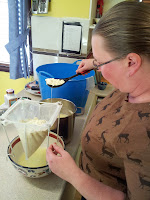Writer: Alex
Participants: Alex
Items: Milk, Flax as Linen
Haloumi is a Cypriot pickled
cheese. This one comes from the Ricki Carroll Home Cheese Making Book, and is very
similar to other recipes I have seen.
The pickling process means
that haloumi keeps for quite some time regardless of the temperature. This
allows it to be easily stored and used in hot weather regions, such as Cyprus
where it was first made. It has a high melting point, which makes it wonderful
for frying in a pan.
Traditionally haloumi was
made with sheep milk. As mentioned previously under the Hard Goats Cheese entry
sourcing sheep milk is problematic. There are a number of modern recipes made
with cows milk.
A number of sources indicate
haloumi has been produced in Cyprus since the medieval Byzantium period around
395-11911AD. Florio Bustron mentions halloumi specifically in 1554AD.
|
Equipment
Large pot or water bath
Slotted spoon
Cheese thermometer
Colander
Fine muslin cheese cloth
(or linen)
Large bowl
Cheese press
|
Ingredients
6Lt unhomogenised cows
milk
1 tablet of rennet
3/4 a packet of Mesophilic
starter
100g cheese salt
3ml calcium chloride
1/4 cup of unchlorinated
water
Brine:
900g of cheese salt
4Lt cold water
|
Method
- slowly heat milk to 30oC (around 30 minutes)
- add calcium chloride and gently stir for 1 minute
- add starter culture and stir slowly from top to bottom for 1 minute
- dilute rennet in unchlorinated water and add to milk
- cover and leave to ripen at 30oC for 45 minutes
- When you achieve a clean break, cut the curd into 1/2 inch cubes
- slowly increase the temperature to 40oC (2o every 5 minutes) stirring gently to the curd does not matt.
- maintain 40oC for 20 minutes
- line your colander with the muslin
- gently scoop the curd into the muslin using a slotted spoon, reserving the whey
- line your cheese press with muslin
- transfer the curd from the colander to the cheese press
- cover with muslin, add the follower and press for 1 hour at 13kg
- remove the cheese, undress, flip and redress.
- put back into the press (with muslin and follower) for 1/2 hour at 22kg
- remove from press and undress
- cut the cheese into 3inch cubes
- heat the reserved whey to 80-90oC
- place the curd in the whey and soak for 1 hour
- when the curd is the look of poached chicken remove and strain into a colander
- allow to cool for 20 minutes
- sprinkle the curd with 100g of salt and further cool for 2-4 hours
- combine 900g of salt and 4Lt of cold water to make brine
- add the cheese to the brine
- cheese will keep up to 60 days.
Specific Photos
Reserving the whey for
cooking the pressed cheese in
Final product in brine and
fried for taste testing. Yum!
Notes
- Temperature control is not my friend. Initially rose to 38oC during ripening because I did not close the curtain (the sun was at the right/wrong angle and kept warming the pot). I finally noticed and managed to get the temperature back to 32oC, which was still a little high but much better.
- The original recipe calls for 1/2 a tablet of rennet. After letting the milk ripen for 1.25 hours without it setting I decided to add the other half of the tablet (most of my other recipes as well as the instructions on the rennet tablet packet say that 1 tablet should be used for 4Lt of milk). After doing this, it took an additional 25 minutes to ripen to a clean break.
- The final pressing of the cheese calls for 22kg. My little press is only marked to 20kg, so I guesstimated where 22kg would be.
- Haloumi is both a salted and brined cheese, which can make the final product quite salty in taste.
- The brine that this recipe calls for is the same ratios as the brine for soaking the Gouda and other hard cheeses. I am a little perplexed as to why it calls for a cold brine infusion, rather than make it the day before and allow it to cool overnight, but followed the instructions anyway. Next time I think I will make the brine the day before to save the tediousness of making it cold (took an hour to infuse).
- Tasting the cheese in the end was very salty, which was expected. We fried a batch without washing/rinsing and also fried a batch rinsed. The rinsed batch was certainly less salty, and I would think that letting it soak in clean water for a half hour before frying would reduce the salt content considerably again.




No comments:
Post a Comment